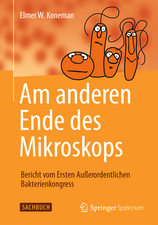Ecology of Central European Forests: Vegetation Ecology of Central Europe, Volume I
Autor Christoph Leuschner, Heinz Ellenbergen Limba Engleză Hardback – 6 noi 2017
| Toate formatele și edițiile | Preț | Express |
|---|---|---|
| Paperback (1) | 1887.92 lei 38-44 zile | |
| Springer International Publishing – 30 aug 2018 | 1887.92 lei 38-44 zile | |
| Hardback (1) | 1894.63 lei 38-44 zile | |
| Springer International Publishing – 6 noi 2017 | 1894.63 lei 38-44 zile |
Preț: 1894.63 lei
Preț vechi: 2492.94 lei
-24% Nou
Puncte Express: 2842
Preț estimativ în valută:
362.59€ • 377.14$ • 299.33£
362.59€ • 377.14$ • 299.33£
Carte tipărită la comandă
Livrare economică 11-17 aprilie
Preluare comenzi: 021 569.72.76
Specificații
ISBN-13: 9783319430409
ISBN-10: 3319430408
Pagini: 675
Ilustrații: XXXIV, 972 p. 527 illus., 41 illus. in color.
Dimensiuni: 155 x 235 x 57 mm
Greutate: 2.15 kg
Ediția:1st ed. 2017
Editura: Springer International Publishing
Colecția Springer
Locul publicării:Cham, Switzerland
ISBN-10: 3319430408
Pagini: 675
Ilustrații: XXXIV, 972 p. 527 illus., 41 illus. in color.
Dimensiuni: 155 x 235 x 57 mm
Greutate: 2.15 kg
Ediția:1st ed. 2017
Editura: Springer International Publishing
Colecția Springer
Locul publicării:Cham, Switzerland
Cuprins
Part I. The natural environment and its history.- 1. Environmental and historical influences on the vegetation of Central Europe.- 2. Life forms and growth types of Central European plant species.- PART II. THE ROLE OF MAN.- 3. The Central European vegetation as the result of millennia of human activity.- PART III. General ecology of Central European forests.- 4. Abiotic conditions, flora, ecosystem functions and recent human influence.- PART IV. FOREST AND SHRUB FORMATIONS.- 5. Beech and mixed beech forests.- 6. Mixed broadleaved forests poor in beech outside of floodplains or mires.- 7. Pure and mixed coniferous forests.- 8. Forest plantations and clearings.- 9. Woody vegetation of floodplains and swamps.- 10. Epiphyte vegetation.- 11. Forest edges, scrub, hedges and their herb communities.- 12. Syntaxonomic overview of the vascular plant communities of Central Europe: Forest and scrub formations.
Textul de pe ultima copertă
This is a comprehensive handbook in two volumes covering the heart of the continent, including Germany, Poland, the Netherlands, Belgium, Luxembourg, Switzerland, Austria, Czech Republic and Slovakia. Based on a thorough literature review with 5500 cited references and illustrated with nearly 1000 informative figures and tables, all vegetation types of this region are analysed in terms of the climatic and edaphic influences, the structure and dynamics of their communities, the ecophysiological constitution of the main plant species, important aspects of ecosystem functioning, and recent conservation issues. This volume deals with forest and scrub vegetation, be it natural or man-made, whilst Volume II is dedicated to the open habitats containing non-forest vegetation such as mires, grasslands, heaths, alpine habitats and urban vegetation. Chapters 1 and 2 of this volume present the climatic, geological and pedological characteristics of Central Europe and provide a short introduction to its phytogeography. Chapter 3 gives a concise overview of the pervasive impact of man on the ecosystems and landscapes of this region over the last 7000 years, referring to both forests and non-forest vegetation. General aspects of the ecology of Central European tree species and forests are summarised in Chapter 4, which also contains a brief review of recent anthropogenic stressors of forest ecosystems, notably over-use, climate change, and the atmospheric deposition of nitrogen and strong acids. Chapters 5, 6 and 7 deal with the broadleaved and coniferous forest communities not shaped by flooding or high water tables. Forest plantations are the topic of Chapter 8, followed by floodplain and swamp forests (Chapter 9), forest epiphytic vegetation (Chapter 10), and the scrub vegetation of forest edges and hedges (Chapter 11). The summarising chapter (12) gives an overview of the most important plant communities of Central Europe.
Caracteristici
A comprehensive overview and up-to-date synthesis of Central Europe's forest ecology and ecophysiology of tree species including about 3000 references Gives a complete account of all forest communities in this region, their historical development, recent climatic and edaphic influences, productivity, biogeochemical fluxes, and forest dynamics Includes nearly 500 informative figures, tables and photographs















